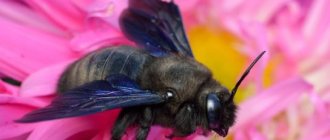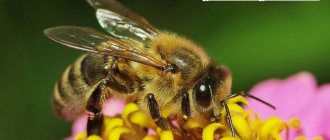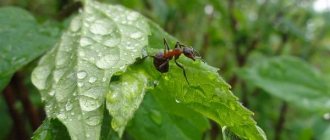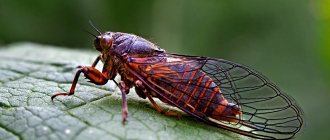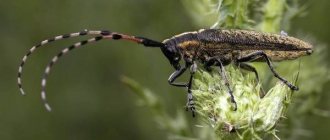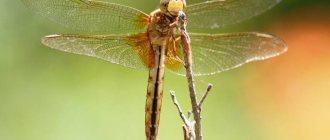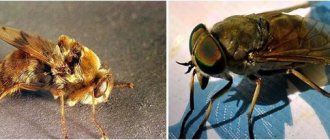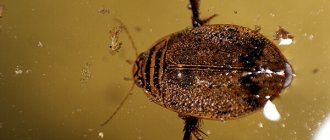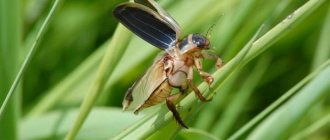Description and features
Everyone knows from childhood that honey is a healthy, nutritious and amazing product. It does not deteriorate, being stored for centuries, it treats a huge variety of diseases, and contains a whole set of substances essential for health and unique enzymes.
Every child also knows that honey is naturally produced by insects called bees. This substance is flower nectar, transformed in a special way, that is, digested to a certain stage in the crop of these small honey-bearing creatures.
Our story is about bees - tireless in their hard work, insects that supply not only humans, but also many other creatures on Earth with such a valuable and irreplaceable product.
A bee is an insect about 3 cm in size. Its color scheme is composed of black stripes, which alternate with yellow-orange areas. These creatures are completely covered with hairs that perform protective functions and play the role of organs of touch.
Thanks to bees, people receive a valuable and healthy product - honey.
Their body is divided into three sections, fastened together by elastic thin membranes. The first is the small head; Next comes the chest - the torso area is a little larger; and the last section and the most significant in size is the abdomen.
All these parts of the body are perfectly shown in the photo of a bee . In addition, these creatures have six legs and are endowed with two pairs of thin wings that differ in size, connected to each other in flight by means of microscopic hooks.
The bee's senses are extremely interesting and complex. First of all, these include the eyes, of which there are essentially five. Two compound eyes, clearly visible on both sides of the head, are built from small facets. Their number is enormous, amounting to thousands of microscopic elements.
An interesting feature of the bee is the presence of five eyes.
There are three simple eyes, they are located on the crown of the insect. And all these components of the visual organs allow the bee to perceive polarized light and rays of the ultraviolet spectrum. These creatures are able to see blue and yellow colors, which cannot be said about shades of red.
The antennae on their heads serve as olfactory organs; in addition, they help them sense cold and heat, determine humidity and the concentration of gases in the air. Bees hear with their legs and some parts of the body. The long proboscis on the head allows them to collect flower nectar, and taste organs are also located on it.
Bees belong to the large order Hymenoptera. And they are related to wasps, similar to them in many structural features. Also, ants are considered close relatives of the described creatures and their brothers in the order, although they do not belong to the category of insects similar to bees .
Rather, some species of flies resemble our honey-bearing creatures in appearance, for example, the so-called hoverfly. It also has a striped abdomen with orange areas, and also makes a similar buzzing sound. This is a striking example of a simple, often described by biologists, mimicry.
That is, nature endowed such a fly with the appearance of poisonous insects, which includes the bee, for the purpose of self-defense. Therefore, at a superficial glance, it is easy to confuse a bee with a hoverfly.
Distinctive characteristics of bee varieties
The breed characteristics of bees are formed over millions of years of evolution. Vital features were developed according to climatic conditions, food sources existing in a certain area, and features of the natural landscape for camouflage and protection.
An important characteristic of insects is regional affiliation. It is based on such characteristics as color and structural features of the proboscis. Light-colored insects are adapted to the southern climate because they do not overheat in the sun. Gray and black colors are typical for regions with harsh climates.
The length of the insects' proboscis affects their feeding habits. Bees with a proboscis from 6.8 to 7.5 mm are adapted to forbs. A shorter proboscis works better in monocultures.
Types of bees
There are a huge number of bee species known. In total, there are more than two tens of thousands of them all over the world. All bees are divided into two categories: domestic and wild.
It is no secret that people have been breeding these insects to produce honey since time immemorial. But not only it, but also other valuable substances: propolis, wax and medicinal poison. But wild bees .
They are somewhat smaller in size. Their color should be called primitive, its shades are not very bright, rather muted, and the color schemes are mostly monochromatic. The chest of savages is equipped with a protective shell.
The hairs on their body grow much thicker than those of their domesticated counterparts, playing the role of a coat of insects that saves them during periods of bad weather and cold weather.
The size of wild bees is much smaller than that of domestic bees.
Of the vast varieties of the bee kingdom, it is worth highlighting the most interesting. And the first ones that need to be mentioned are real bees. This is the name of a whole family, which includes about five thousand varieties. Among them:
1. Honey bees - most breeds of such bees have been used by people for a long time and are therefore well known to them. At first, our very distant ancestors simply found shelter for such insects in tree hollows and took honey from them. But gradually they began to breed them, keeping them in logs, either built from bark or made from clay.
Much later, houses for these honey-bearing creatures, called beehives, began to be built. And they invented easy-to-use frames. It is very easy to extract honey from such structures along with the honeycombs containing it.
2. Bumblebees are a whole genus of bees similar in many ways to their honey-bearing counterparts. In total, about three hundred species of such insects are known. They live on all continents of the Northern Hemisphere. Among their relatives, they have earned the reputation of being the most cold-resistant. By the way, this greatly increases their chances of survival.
Bumblebees have the opportunity to fly out to collect nectar in the early morning, when the rays of the gentle spring or summer sun have not yet warmed the air. In this way, they are ahead of their competitors and collect all the delicious things from flowers and other plants.
The outfit of each type of bumblebee is different. Some of them have yellow stripes alternating with black, while others have orange or red stripes. There are also completely dark varieties.
Bumblebees also belong to the bee family
Among the representatives of this insect kingdom there are real giants, which are noticeably larger than the bee to which we are all accustomed. A striking example of this are specimens of the genus Megachila. And their size is really impressive, because their wingspan can reach 6 cm. By the way, these bees are not capable of producing honey at all. They live in colonies and are famous for their particular aggressiveness.
In the photo there is a carpenter bee
Central Russian (dark forest, Central European, actually honey-bearing) (Apis mellifera mellifera). Bees of this breed inhabited forests that grew during the post-glacial period and spread widely in western, central, eastern and northern parts of Europe. The natural distribution of Central Russian bees reached the Urals, and starting from the 18th century. they were brought to Siberia, Central Asia, Transbaikalia, and the northern regions of the European part of the country.
The color of the chitin of worker bees is uniform, dark gray, the length of the proboscis ranges from 6 to 6.4 mm depending on the geographic latitude of the area and seasonal changes. The conditional width of the third tergite of worker bees (the distance between the projections) is on average 5 mm. The weight of a bee at one day of age is 110 mg, that of a barren queen is 190 mg, that of a fertile queen is 210 mg. and more.
Bees of this breed have absolutely no tendency to quietly change and cohabitate queens. They do not protect their nests well from thieving bees and are much less prone to bee theft than the southern breeds. When inspecting the nest, the bees hang on the frames in “clusters” and are aggressive and restless. The honey signet is “dry”, white.
In the conditions of central Russia, Central Russian bees make good use of the strong mid- and late-summer honey flow, especially from linden and buckwheat. Western populations are specialized in using honey from heather. Intensely visiting the flowers of honey plants of the same species (linden, buckwheat, fireweed), bees relatively slowly switch to newly emerging sources and are characterized by weak enterprise in finding them. The reduced migration ability, which prevents Central Russian bees from effectively using polyfloral, as well as any relatively weak, unstable honey flow, is apparently also explained by the conditions for the formation of this breed.
When the honey harvest begins, honey is stored mainly in the store part of the nest and in much smaller quantities in the brood area. In addition, they tend to create abundant reserves of beebread in the brood part of the nest.
During the wintering period, the colonies of these bees maintain a fairly high carbon dioxide content (up to 4%) in the club. As a result, the club retains its stability, and bee colonies react weakly to sudden changes in air temperature in the winter hut.
As a result of evolution, which took place in rather harsh climatic conditions, bees have developed certain adaptations to unfavorable weather, which were consolidated through the process of natural selection. Bees have exceptionally good winter hardiness, great endurance and resistance to some diseases (foulbrood, nosematosis, honeydew toxicosis). This gives them the opportunity to adapt to living conditions in cold areas (up to 60° N), where bees of other breeds cannot live.
Under favorable conditions, during the period of intensive spring development of bee colonies, Central Russian queens lay up to 2000 eggs per day. This allows you to increase the honey collection from linden and buckwheat families to a fairly large capacity, which collect a lot of propolis.
Undesirable qualities of bees of this breed are strong malice and high playfulness. It should be borne in mind that swarming manifests itself to a significant extent in bee colonies with old queens.
Thus, having a number of disadvantages (strong malice, high swarming, etc.), Central Russian bees, due to their good winter hardiness and resistance to a number of diseases, high egg production of queens, the ability to grow strong bee colonies, etc. represent valuable material for breeding.
On the territory of our country, Central Russian bees are represented by several populations. Among them we can distinguish Bashkir bees that live in the forests of the Burzyansky Reserve, Ural mountain-taiga bees that have adapted to the conditions of the Northern Urals, and Altai bees. Local populations of Central Russian bees have survived in Tatarstan and Belarus.
Bees of this breed are bred mainly in the non-chernozem zone of the Russian Federation. Reproduction of queens of the Central Russian breed is not yet sufficiently established. Their breeding is carried out by the Oryol and Bashkir experimental beekeeping stations. Currently, the Bashkir breeding team has begun active work. On the territory of Bashkortostan there is a unique reserve of bees of this breed “Shulgan-Tash”.
Ukrainian steppe (Apis mellifera acervorum). Bees of this breed live in the steppes and southern regions of the forest-steppe zone of Ukraine.
There are two opinions about the origin of this breed: some researchers consider Ukrainian steppe bees to be an isolated southern branch of Central Russian bees, others associate their origin with bees of the Carpathian breed.
The body color of the worker bee is gray, the length of the proboscis is 6.3-6.7 mm, the conditional width of the third tergite is on average 4.8 mm. The weight of a one-day bee is about 105 mg, a barren queen is 180 mg, and a fertile queen is 200 mg.
Bees of this breed are less malicious than Central Russian bees, their behavior when opening and inspecting the nest is more calm. The honey signet is predominantly white, “dry”.
The polising of nests is average, and the level of enterprise in finding new sources of honey collection is low. Relatively strong honey collection is used well.
Ukrainian steppe bees are quite winter-hardy, hardy and resistant to a number of diseases.
The fertility of queens during the period of the most intensive development of bee colonies can reach up to 1800 eggs per day, which allows bees of this breed to build up strong colonies. Bees are quite swarming, but with the help of generally accepted anti-swarming techniques they switch to a working state.
This breed is most promising for breeding in the steppe and southern forest-steppe zones of Ukraine, where it is recommended for zoning.
A number of adjacent regions and districts of Ukraine have entered the reserve zone for the conservation and improvement of Ukrainian steppe bees.
Carpathian (Apis mellifera carpatica). The natural habitat of this breed is the Carpathians and their foothills. Carpathian bees are tended to be considered one of the populations or branches of the Krajina breed.
Worker bees are gray in color, the length of their proboscis is 6.3-7.0 mm, the conditional width of the third tergite is 4.8 mm, the weight of a bee at the age of one day is on average 110 mg, of non-fertile queens - 185 mg, of fertile queens - 205 mg. One of the attractive qualities of bees of this breed is their peacefulness, which allows the beekeeper to work with them without a net or smoker throughout the season, as well as calm behavior on the honeycomb when inspecting the nest.
The signet of honey in Carpathian bee families is predominantly white, “dry”, but it can also be found mixed. The tendency to collect propolis is almost completely absent. They are distinguished by good enterprise in finding sources of honey collection, and quickly switch from old to new.
Carpathian bees pollinate legumes more intensively than Central Russian bees. Honey is placed first in the brood chamber and then in the store part of the nest.
Bees of this breed are distinguished by good winter hardiness (although less winter hardy than Central Russian ones) and relatively high resistance to honeydew toxicosis, nosematosis, and European foulbrood. Nests are poorly protected from wax moths.
The fertility of Carpathian queens is quite high and during the period of intensive spring development of bee colonies reaches 1800 eggs per day.
In the absence of sources of honey flow, after the period of spring development, up to 1/3 of bee colonies may enter a swarm state, but as a result of the use of simple anti-swarm techniques or when honey flow appears, the working state is restored.
Wax productivity is quite high; in this indicator, Carpathian bees are second only to bees of Central Russian and Italian breeds.
Nurseries in Transcarpathia and Moldova are engaged in the reproduction of queens of the Carpathian breed. In Russia, the Maykop beekeeping stronghold, as well as the Kislovodsk bee breeding nursery, are successfully engaged in the selection and reproduction of Carpathian bees.
Caucasian mountain gray (Apis niellifera caucasica). Bees of this breed have long lived in the mountainous regions of the Caucasus and Transcaucasia.
The color of the chitin of worker bees is uniform, gray. Worker bees have the longest proboscis among other bee breeds - up to 7.2 mm. The conditional width of the third tergite averages 4.7 mm. The weight of a one-day worker bee is 90 mg, a barren queen is 180 mg, and a fertile queen is 200 mg.
The first scientific description of these bees was made in 1916 by K. A. Gorbachev, and A. S. Skorikov and V. V. made valuable contributions to their study. Alpatov.
Bees of this breed are extremely peaceful; when inspecting nests, they calmly work on the honeycombs. Nests are well protected from thieving bees. The honey is sealed with a dark, “wet” seal. Prone to bee theft. They are enterprising in finding new sources of honey collection and easily switch from one type of honey plant to another. Even with a relatively weak honey harvest, gray mountain Caucasian bees collect significant reserves of honey. This is to a certain extent facilitated by the characteristic behavior of worker bees, which consists in limiting the queen’s egg laying and completely switching to collecting honey. The species composition of honey plants used is much wider than that of Central Russian bees.
They are good pollinators of legumes, in particular clover.
When the honey harvest begins, the honey is first stored in cells that are freed from brood, and only after the nesting frames are filled with honey they move to the second building or magazine extension.
They bring a lot of propolis and for the winter they seal all the cracks in the hive with it and reduce the size of the entrance. In terms of wax productivity they are inferior to Italian and Central Russian ones. There is a strong tendency towards quiet replacement and cohabitation of queens.
When breeding gray mountain Caucasian bees in the central and northern regions, it is necessary to take into account their low winter hardiness compared to Central Russian bees. They are very sensitive to honeydew impurities in winter feed and are significantly affected by nosematosis and European foulbrood.
The fertility of the queens is relatively low and during the period of the most intense oviposition, as a rule, does not exceed 1500 eggs per day.
The swarming rate of bees of this breed is extremely low (no more than 3% of bee families swarm in a season). They easily switch from a swarming state to a working one, for which it is enough to remove the swarming queen cells and sharply expand the nest. Only 2-5 queen cells are laid.
Due to the previously noted qualities (peacefulness, weak swarming, effective pollination of legumes, high enterprise in finding new honey plants, the ability to productively use even weak honey yield), gray Caucasian mountain bees are of great interest for breeding.
Several populations have been identified in the breed, differing in a number of features: Megrelian, Abkhazian, Kartalinsky, Kakheti, Imeretian, Gurian, etc. The bees of the Megrelian population are distinguished by the longest proboscis.
When breeding bees in the central regions, it is necessary to improve their winter-hardy qualities as a result of selection, and it is also desirable to increase the egg production of queens and use high-mountain populations (Mingrelian, etc.).
The selection and reproduction of queens of this breed is traditionally carried out by the Krasnopolyansk Experimental Beekeeping Station and nurseries in Georgia, Azerbaijan and the North Caucasus.
Yellow (valley) Caucasian (Apis mellifera remipes). The breed is common in the valleys of Georgia, Armenia, and Azerbaijan.
There is significant yellowness in the color of chitin. The length of the proboscis of worker bees of this breed ranges from 6.5 to 6.9 mm, the conditional width of the third tergite is 4.7 mm. The weight of a bee at one day of age is 90 mg, the weight of a barren queen is 180 mg, and the weight of a fertile queen is 200 mg.
Yellow Caucasian bees are prone to bee theft; honey is sealed with a dark, “wet” seal. These bees are adapted to mild, warm climates; in more northern areas they winter poorly and are susceptible to diseases.
The fertility of queens is relatively low, and its maximum value does not, as a rule, exceed 1700 eggs per day.
Bees are highly swarming. Up to 80% of bee colonies enter the swarm state, laying up to 300 queen cells. A family can swarm several times; in a swarm there are up to several dozen infertile queens.
This breed is also associated with Kuban bees, which live in the North Caucasus - in the Krasnodar and Stavropol territories, and Armenian bees. There are several other populations of bees of this breed.
Bees of this breed were widely used in Russia in the post-war years to restore beekeeping. Traces of crossbreeding of local bees by yellow Caucasian bees can still be found today. Bees of this breed are not bred in their pure form in the central and northern regions.
Far Eastern bees. These bees are not yet officially recognized as a breed, but they are quite unique and have great breeding value.
Far Eastern bees are common in the Primorsky and Khabarovsk territories and in a number of adjacent regions. Obtained as a result of unsystematic crossing of mainly Ukrainian steppe and Central Russian bees with the participation of Caucasian bees to a lesser extent and Italian bees to a greater extent.
The process of formation of bees of this breed type began relatively recently (the beginning of this century), so there is significant variability in many traits.
The body color of bees is gray or gray with yellowness on the first two tergites. The length of the proboscis ranges from 6.1 to 6.8 mm. The conventional width of the third tergite of bees is about 4.9 mm. The weight of a one-day bee is about 105 mg, a barren queen is 180 mg, and a fertile queen is 230 mg.
Far Eastern bees are relatively peaceful, especially during the main honey flow. When inspecting nests, they most often behave calmly. Signet of honey mixed. Very little propolis is collected.
In terms of enterprise in finding new sources of honey collection, they are superior to Central Russian bees, but inferior to gray Caucasian mountain bees. They use the strong, stormy honey flow from the linden tree extremely effectively, bringing up to 10 kg of nectar on some days. Honey productivity - 100 kg or more is considered common. Honey is piled equally evenly in the brood and store parts of the nest. There are no cases of quiet replacement and cohabitation of queens. They protect their nests well from wax moths.
The winter hardiness of bees is quite good. Nosema, honeydew toxicosis, and foulbrood are affected to a lesser extent than southern breeds, but are inferior to Central Russian ones.
The fertility of queens is relatively low and amounts to 1100-1600 eggs per day.
The ability to deconstruct cells is low. In terms of wax productivity, Far Eastern bees are superior only to gray Caucasian mountain bees.
The swarm instinct appears before the main honey flow begins. During this period, up to 50% of bee colonies enter a swarming state, which can be stopped either by the beginning of a strong honey flow or the formation of layering.
Far Eastern bees are conventionally divided into two populations: gray and yellow.
Italian (Apis mellifera ligustica). Origin and natural range: Italy. The breed is widespread throughout the world.
The body color of worker bees is yellow, the length of the proboscis is 6.4-6.7 mm, the relative width of the third tergite is 4.8 mm. The average weight of a worker bee is 115 mg, a barren queen is 190, and a fertile queen is 210 mg.
Bees are very peaceful and behave relatively calmly when inspecting nests.
The signet of honey is heterogeneous and mixed.
Bees are very prone to theft, but they defend themselves well against thieving bees.
The spring development of bee families begins relatively late, proceeds for a long time, but very intensively, and ends by mid-summer, when the families reach great strength due to the high egg production of the queens.
Bees are distinguished by their exceptional resourcefulness in finding sources of honey collection and the ability to quickly switch from the worst honey collection to the best.
When the honey harvest begins, the honey is placed first in the store part of the nest, and then in the brood area.
They overwinter in strong families, so food consumption is high.
In countries with a continental climate (Finland), wintering is even better than in countries with Atlantic influence, where recurrent spring cold snaps are typical.
Italian bees are the most resistant to acarapidosis, but much more strongly than Central Russian bees are affected by honeydew toxicosis, nosematosis and European foulbrood.
The swarming behavior is moderate; no more than 30% of bee colonies enter the swarm state, and they relatively easily switch from the swarm state to the working state. If there is enough space in the nest for development, colonies with young queens may not release a single swarm for the entire season. This is a very valuable quality for industrial beekeepers who do not have the opportunity to frequently inspect nests.
Bees work relatively effectively in pollinating entomophilous crops (in particular, clover), inferior to bees of the Caucasian and Krajina breeds. They are distinguished by the highest wax productivity.
Italian bees represent valuable material for selection due, first of all, to the high egg production of queens. US beekeeping is based exclusively on this breed. They are successfully bred in Finland.
Krainskaya (Apis mellifera carnica). The origin of this breed and its original range are the areas of the South-Eastern Alps, Yugoslavia, Austria.
Within the breed, populations are distinguished such as Alpine (Austria, Slovenia, Slovakia), Pannonian (Hungary, Carpathians, most of Yugoslavia), etc. Many authors tend to consider the Carpathian breed a Carnika population.
The body color of bees is gray, with a silvery tint, the length of the proboscis is 6.4-6.8 mm, the relative width of the third tergite is 4.9 mm. The weight of a one-day worker bee is 110 mg, a barren queen is about 185, and a fertile queen is about 205 mg.
The bees are peaceful, calm, and remain on the honeycombs when inspecting the nest.
Krajina bees are exceptionally enterprising in finding food sources and quickly switch from the worst source of honey collection to the best.
When the honey harvest begins, honey is placed first in the brood part of the nest, and then in the store part.
Bees of this breed are more winter-hardy than Caucasian ones, but less winter-hardy than Central Russian ones. In winter they go in small families. In terms of resistance to honeydew toxicosis, they are superior to all other bee breeds, and in terms of resistance to nosematosis and European foulbrood, they are somewhat superior to Caucasian bees and noticeably inferior to Central Russian bees.
The spring development of families begins very early and proceeds intensively. They use early honey collection much more efficiently than bees of other breeds. Honeydew “forest” honey is effectively collected.
The maximum fertility of queens is quite high and amounts to 1400-2000 eggs per day (during the period of intensive spring development). Families relatively easily switch from the swarm state to the working state upon the onset of at least a weak honey flow or the use of conventional anti-swarm techniques.
The polising of the nest is weak, the honey seal is mixed.
Krajina bees pollinate red clover better than Central Russian ones, but somewhat worse than Caucasian ones.
They are suitable for breeding in areas with a cool climate and low, long-term honey production, as well as for areas where there are conditions for collecting honeydew honey, which is in great demand in European countries. Beekeeping throughout Western Europe is based on bees of this breed.
The global gene pool of bees is not limited to the listed breeds bred in our country. The following breeds are quite well known: Greek (Amcecropia), Cypriot (A. m. cypria), Syrian (A. m. syriaca), Palestinian (Amsaneta), Anatolian (Aminsularium), Iranian (A. m. iranica) .
The richest gene pool of bees is concentrated in Africa. North African black bees (A. m. intermis-sa), Reef (A. m.majgor), Saharan (A. m. sachariensis), Egyptian (Amlamarckii), Sudanese (A. m. nubica) and many others live there. others, among them A. m. adansonii, which has gained a bad reputation due to its aggressiveness.
Lifestyle and habitat
Bees take root in any area of the planet where flowers grow. They are the main source of their nutrition. And it is from plant nectar, as already mentioned, that these insects produce honey. It is no secret that for flowers these creatures also play an important role as natural and most active pollinators. And many species of earthly flora without bees would not be able to exist and reproduce successfully.
Where the domestic representatives of the kingdom of these insects live has already been mentioned - in beehives . But their wild relatives try to settle down in forest hollows, crevices, and burrows. If the climate of the area is quite mild, then the bee's nest is most often simply suspended high in the trees. Sometimes they are located between walls or in the attic of houses.
The nests of the described insects are structures made of double-sided vertical honeycombs. And without them it is impossible to even imagine the life of a bee colony (that is, a swarm, as such colonies are usually called).
Wild bees choose hollows and crevices in trees for nesting.
Such cells, which have the correct shape and look like a hexagon, are built from the wax secreted by these insects. Each type of bee has its own honeycomb size, usually corresponding to the size of the insects themselves.
And the inhabitants of the nest always carefully monitor their integrity. When fresh, that is, initially, the cells have a white tint, but over time they darken.
These insects live in colonies, the members of which are divided into castes. But the types that make up the bee family should be described in more detail.
1. Worker bees are the most numerous caste, the representatives of which mainly make up the bee nest. These are what we usually see in everyday life, when we are in nature. The number of this type of inhabitants in a nest can reach up to 80 thousand.
What do bees do ? They do the main work, that is, searching for suitable plants and extracting nectar from them. All working insects are underdeveloped females. They appear precisely and only from fertilized eggs.
2. Queen - this creature in the bee family is the only full-fledged female. And all the other members of the swarm come from her. Since the queen gives life to the entire community, she is in a revered position, therefore she feeds on worker bees and is carefully guarded by them.
This is natural, because without a uterus, family members are at risk of extinction. The others recognize that the swarm has it by the smell emanating from it. If this is not observed, this serves as an alarm that the uterus has died and a new one needs to be grown.
3. Drones are males whose purpose is to fertilize the uterus, and they have no other duties. They are larger than the working members of the family and emerge from unfertilized eggs. And much more food is used to fatten them.
Therefore, if they are no longer needed, the drones are mercilessly expelled by other family members. Sometimes they end up in other nests. But during the onset of cold weather, when the collection of flower nectar and active reproduction ends, they have no choice but to die from hunger and cold.
The rest of the bees in winter are also suddenly forced to change their usual way of life. Beekeepers take care of keeping domestic insects. And their wild counterparts become saturated with wax and propolis and climb into the cracks.
Functions of a bee colony
It turns out that the bee family includes:
- Worker bees, which do everything that bees do: process pollen to produce other derivative products, feed the queen bee, guard the hive, etc.
- The queen bee only produces offspring. Each fertilized egg produces a female, and each unfertilized egg produces a male.
- Drones - they are necessary only for brood; they do not bring any other benefit to the bee colony.
Nutrition
It is already clear that the most important product that these insects eat is honey. But the quality of this substance depends on many factors. For example, from how these little creatures survived the hardships of winter. In addition, the taste of honey is greatly influenced by the type of plant from which the nectar is extracted.
It is best that these representatives of the flora do not contain excess glucose, sucrose and carbohydrates, because such elements contribute to the accelerated crystallization of this product. And in this form, honey cannot be fully consumed by bees.
And even after collecting a significant amount of this substance, they are quite capable of dying of hunger. Undesirable plants, for example, include mustard, heather, cotton and some others.
In cases where its nutrition is not of sufficient quality, the bee suffers greatly. And all members of the nest become susceptible to disease and feel unwell. Good honey plants include: apple, cherry, pear, willow, linden and many others.
Content
- 1 Life cycle
- 2 Swarm behavior
- 3 Progress of tasks 3.1 Cleaning cells (days 1-2)
- 3.2 Nurse (days 3–12)
- 3.3 Wax production (days 13–18)
- 4.1 Honey sealing
Reproduction and lifespan
Depending on various intrafamily circumstances, a swarm of bees produces buzzing sounds that are different from each other in timbre and pitch. Therefore, experienced beekeepers are quite capable of understanding what is happening inside the bee house by the sounds of the hive.
The noise of a nest makes it possible, for example, to find out that the insects inside it are cold. It also talks about other problems, because each caste of the family “sings” with its own voice.
When the inhabitants of the hive are about to swarm, they also make strictly defined sounds. This occurs when the members of the nest have decided to split into two families. In this case, one part of the swarm flies away with the old experienced queen. And in the depths of the former, a young female is raised.
To develop the future queen, bees build special honeycombs. This “queen” of the family emerges from a fertilized egg. And when it turns into a larva, it is fed with special milk. It is the quality of the food that determines whether a female egg will produce an ordinary worker bee or a queen bee.
The latter's ability to reproduce a bee swarm appears already at ten days of age. The queen bee has a huge number of contacts with drones throughout her life. And they are not even calculated in billions, but in numbers with a huge number of zeros.
At the same time, the mass of eggs that the successor of the bee family lays per day often exceeds its own live weight. But as the uterus ages, the quality of the offspring changes. At the same time, in the third year of life, more and more drones appear in the hive, and this is already bad for the survival of the family.
Worker bees usually exist in the world for no more than 40 days. But if they appear in the family closer to autumn, then, including the passive winter period, they can live up to six months. The lifespan of drones is even shorter. However, the uterus in this sense is a record holder. She can sometimes live up to 4 years.
Life cycle of worker bees
When winter ends, at the beginning of the first spring month, before it gets warmer outside, the queen becomes more active and begins laying eggs. Each egg falls to the bottom of the honeycomb cell. Three days later, larvae emerge from the eggs of the first clutch, which the worker bees begin to feed. To feed the larvae, bees bring royal jelly in small quantities. Feeding with milk lasts about 2 days, then the brood is transferred to feeding on the so-called “bee bread”, consisting of pollen, honey or nectar.
After another 6 days, the larvae are sealed in the honeycombs with a wax layer. Inside the cell, the larvae spin cocoons and pupate. Before pupation of the larvae, the middle and posterior parts of the intestine are connected, which leads to complete cleansing and removal from the body of waste accumulated over the entire period. During the pupal stage, significant changes occur in the appearance and internal structure of the body, wings, legs, stings develop, and the nervous system is formed.
Individuals that emerge from the cells after 12 days, in the guise of young bees, are called “imago” . The period when young individuals emerge from the cells falls in early spring, so they wait until the peak of spring flowering to begin foraging - storing nectar in the crop, which is enough to feed the bee colony during the active season.
Find out why bees are dying.
What to do if you are bitten by a bee?
The sting of this creature is located at the end of the abdomen. It has a notch, due to which this insect is not able to survive an enemy attack. The bee's sting gets stuck in the enemy's body, and the helpless creature loses it, which causes the death of the brave defender of the nest.
But the victim himself, who received a portion of the poison, also acquires additional problems from bee loss. After all, the sting can get stuck in the skin and continue to release harmful substances.
The venom of this insect is very effective in composition. At first, the victim feels pain from its action. Then the site where the sting is inserted turns red, then a very unpleasant swelling appears, which subsides only after several (usually two or three) days.
In addition, foreign substances that enter the blood can cause an allergy attack. But at the same time, a bee sting can be useful. After all, the poison of these insects in small doses is endowed with healing properties. It kills bacteria and, in addition to harmful ones, contains many useful substances.
If a person has been attacked by this insect, he should first remove the sting, and then treat the affected area with potassium permanganate or any other antiseptic. Cold compresses also greatly promote healing. In addition, drinking plenty of fluids is beneficial, as it activates the removal of toxic ingredients.
What are the responsibilities of the young, and when does it go on its first flight?
Already on the 2-3rd day, the worker bee begins to prepare and clean the cells for new brood, for honey or bee bread.
In the first 24 hours after the destruction of the cell, the young insect does not perform any work
After 3 days of such work, the young insect is already busy preparing food and feeding the grown 3-day-old larvae. And by the 6th day of life, the bee’s body begins to produce milk, which it feeds the smallest representatives of the brood.
Days 10–12 may be the time of the first flight, which may go unnoticed by the beekeeper due to the crowd of adults. It is good to distinguish young insects in August-September, when the main honey flow takes place.
On the 12th day, the young animals no longer produce milk, so they begin to engage in adult work:
- receiving nectar from foragers;
- processing nectar into honey;
- folding processed nectar into cells and sealing them;
- building honeycombs from wax, which they produce themselves.
Division of work in the hive
If we consider the interpretation of the term “working bees” according to the principle of division of labor, we can see two main types. The first is intended for young females. It includes:
- Milk and wax secretion
- Feeding.
- Care of the uterus.
- The structure of cells on honeycombs.
All this is done by young bees who still cannot fly out of the hive. Their wings are not yet strong enough to travel long distances.
The older bees do the work outside the hive. They bring nectar, water, pollen and so on. It should be noted that young bees will never do the work of older ones, and vice versa.
Links[edit]
- "List of foods dependent on bees for pollination". honeylove.org
. Retrieved November 23, 2022. - Jump up
↑ Finch, Caleb E. (May 16, 1994). Longevity, aging and the genome. University of Chicago Press. paragraph 70. ISBN 978-0-226-24889-9. - Adriana, Pianaro (2007). "Chemical changes associated with invasion of a Melipona scutellaris colony by Melipona rufiventris workers." Journal of Chemical Ecology
.
33
(5):971–984. DOI: 10.1007/s10886-007-9274-5. PMID 17404819. S2CID 32195400. - Cunha, Marcos Guilherme yes; Franchin, Marcelo; Galvao, Livia Camarade Carvalho; Ruiz, AnaLuciaTuscagois de; Carvalho, Joao Ernesto de; Ikegaki, Masarahu; Alencar, Severino Matias de; Koo, Hyun; Rosalen, Pedro Luis (28 January 2013). "Antimicrobial and antiproliferative activity of the stingless bee Melipona scutellaris geopropolis". BMC Complementary and Alternative Medicine
.
13
(1): 23. DOI: 10.1186/1472-6882-13-23. ISSN 1472-6882. PMC 3568042. PMID 23356696. - Guidoux, Valeria (December 15, 2004). Little bees. Gareth Stevens, LLLP Publishing. paragraph 18. ISBN 978-0-8368-4433-7.
- Segers, Francesca (17 January 2015). “The production of soldiers by stingless bees depends on the rearing site and the behavior of the nurse.” Behavioral ecology and sociobiology
.
69
(4):613–623. DOI: 10.1007/s00265-015-1872-6. S2CID 18594915. - Couvillon, M.J.; Wenseleers, T.; Imperatriz-Fonseca, L.; Nogueira-Neto, P.; Ratnieks, F. L. W. (2007). "A comparative study in stingless bees (Meliponini) demonstrates that nest entrance size predicts movement and defense". Journal of Evolutionary Biology
.
21
(1): 194–201. DOI: 10.1111/j.1420-9101.2007.01457.x. PMID 18021200. - Ratnieks, FLW; Helantera, H. (2009). "The evolution of extreme altruism and inequality in insect communities". Philosophical Transactions of the Royal Society B: Biological Sciences
.
364
(1533):3169–79. DOI: 10.1098/rstb.2009.0129. PMC 2781879. PMID 19805425. - Julia S. Jones, S. Fruciano, J. Marchant, F. Hildebrand, S. Forslund, P. Bork, P. Engel, WOH Hughes (May 2018). "The gut microbiome is linked to behavioral task in honey bees". Insectes Sociaux
.
65
(3):419–429. DOI: 10.1007/s00040-018-0624-9. PMC 6061168. PMID 30100619. CS1 maint: multiple names: list of authors (link) - Julia S. Jones, S. Fruciano, F. Hildebrand, H. Al Toufalilia, NJ Balfour, P. Bork, P. Engel, VPT Ratnieks, WOH Hughes (November 2017). "The composition of the gut microbiota in honey bees is linked to the ecological landscape". Ecology and evolution
.
8
(1):441–451. DOI: 10.1002/ece3.3597. PMC 5756847. PMID 29321884. CS1 maint: multiple names: list of authors (link) - Ducker, James (July 13, 2017). "Manchester United and City will wear the 'Worker Bee' badge during the friendly to raise money for Manchester bombing victims" - via www.telegraph.co.uk.
- ↑
Cooper, Matthew (23 May 2022).
"What is a Manchester bee?" . men
. - "Why the worker bee is a symbol of Manchester". innews.co.uk
. May 24, 2022. Retrieved May 25, 2022. - "'Peaceful but not tangled' - how the bee became a symbol of Manchester". The keeper
. May 24, 2022. Retrieved May 25, 2022.
- The Honey Files: The Life of a Bee, Study Guide
, National Honey Board, 2001. - Bee Colony Organisation, FAO
Drones
Despite the fact that there are many legends about the idle life of the drone, its existence can be called rather meager. Moreover, in the process of fulfilling his direct obligations, he dies, like all bees that lose their sting.
The drone's task is not to fly to feed and rest. It is responsible for reproductive function, albeit indirectly. During the flight, he needs to find an unfertilized uterus. After mating, the developed female literally tears out his reproductive apparatus. The result of this action is the death of the individual.
If the drone has not found a queen for fertilization, then it will live normally until the onset of frost. Then, since the hive must be sealed to protect itself from the cold, all individuals that are not performing any duties are simply taken outside, where they also die. At the same time, worker bees are a kind of executioners, since they will be the ones who will have to cleanse the families of additional and useless “hungry mouths”.
Swarm behavior[edit]
When a colony escapes (all bees leave the colony) or divides and thus creates a swarm and then creates a new colony, the bees must regress in their behavior to create the first generation in the new home. The most urgent task will be the creation of new beeswax for honeycombs. Comb is much more difficult to obtain than honey and requires about six times more energy to create. A newly reared swarm on bars (top-bar hive) or empty foundation (Langstroth box hive) will often be fed sugar water, which they can then quickly consume to create wax for a new comb. (Mature hives should not be fed this way as they will store it instead of nectar, although a hive overwintering may need to be fed if the beekeeper has left insufficient honey.)
Symbolism[edit]
Bee art in the northern quarter of Manchester
The worker bee is a symbol of Manchester, England. [11] [12] It was adopted as a motif for Manchester during the Industrial Revolution, a time when Manchester was playing a leading role in new forms of mass production, and symbolizes the hard work of the people of Manchester during this era, and Manchester was a beehive. activities in the 19th century. [13] [14]
Following the attack at Manchester Arena on Monday 22 May 2017, the bee emblem gained popularity as a public symbol of unity against terrorism, appearing on banners and graffiti.
The song "Worker Bees" by Canadian rock band Billy Talent (from their 2006 album Billy Talent II
) criticizes the actions of the US military during its ongoing invasion of the Middle East; comparing it to the hive mind mentality of worker bees.

